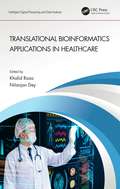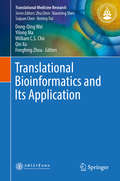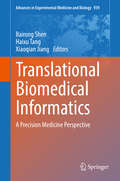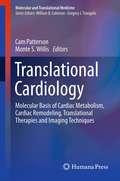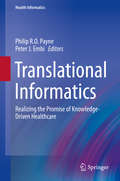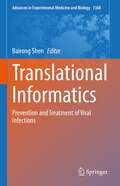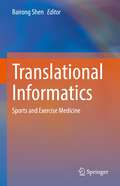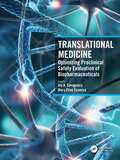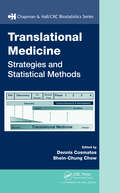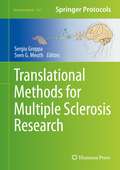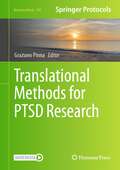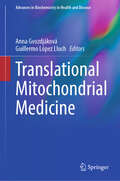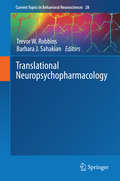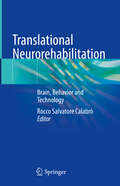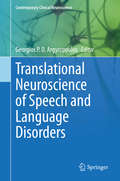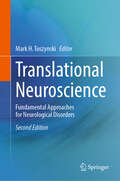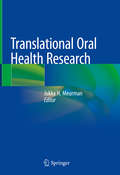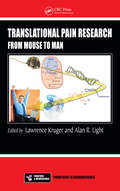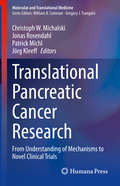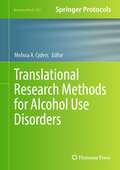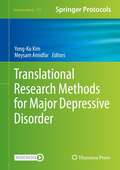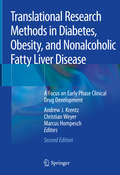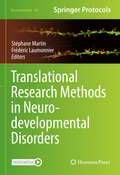- Table View
- List View
Translational Bioinformatics Applications in Healthcare (Intelligent Signal Processing and Data Analysis)
by Nilanjan Dey Khalid RazaTranslational bioinformatics (TBI) involves development of storage, analytics, and advanced computational methods to harvest knowledge from voluminous biomedical and genomic data into 4P healthcare (proactive, predictive, preventive, and participatory). Translational Bioinformatics Applications in Healthcare offers a detailed overview on concepts of TBI, biological and clinical databases, clinical informatics, and pertinent real-case applications. It further illustrates recent advancements, tools, techniques, and applications of TBI in healthcare, including Internet of Things (IoT) potential, toxin databases, medical image analysis and telemedicine applications, analytics of COVID-19 CT images, viroinformatics and viral diseases, and COVID-19–related research. Covers recent technologies such as Blockchain, IoT, and Big data analytics in bioinformatics Presents the role of translational bioinformatic methods in the field of viroinformatics, as well as in drug development and repurposing Includes translational healthcare and NGS for clinical applications Illustrates translational medicine systems and their applications in better healthcare Explores medical image analysis with focus on CT images and novel coronavirus disease detection Aimed at researchers and graduate students in computational biology, data mining and knowledge discovery, algorithms and complexity, and interdisciplinary fields of studies, including bioinformatics, health-informatics, biostatistics, biomedical engineering, and viroinformatics. Khalid Raza is an Assistant Professor, the Department of Computer Science, Jamia Millia Islamia (Central University), New Delhi. His research interests include translational bioinformatics, computational intelligence methods and its applications in bioinformatics, viroinformatics, and health informatics. Nilanjan Dey is an Associate Professor, the Department of Computer Science and Engineering, JIS University, Kolkata, India. His research interests include medical imaging, machine learning, computer-aided diagnosis, and data mining.
Translational Bioinformatics and Its Application
by Qin Xu Dong-Qing Wei Yilong Ma William C. S. Cho Fengfeng ZhouThis book offers a detailed overview of translational bioinformatics together with real-case applications. Translational bioinformatics integrates the areas of basic bioinformatics, clinical informatics, statistical genetics and informatics in order to further our understanding of the molecular basis of diseases. By analyzing voluminous amounts of molecular and clinical data, it also provides clinical information, which can then be applied. Filling the gap between clinic research and informatics, the book is a valuable resource for human geneticists, clinicians, health educators and policy makers, as well as graduate students majoring in biology, biostatistics, and bioinformatics.
Translational Biomedical Informatics
by Bairong Shen Haixu Tang Xiaoqian JiangThis book introduces readers to essential methods and applications in translational biomedical informatics, which include biomedical big data, cloud computing and algorithms for understanding omics data, imaging data, electronic health records and public health data. The storage, retrieval, mining and knowledge discovery of biomedical big data will be among the key challenges for future translational research. The paradigm for precision medicine and healthcare needs to integratively analyze not only the data at the same level - e. g. different omics data at the molecular level - but also data from different levels - the molecular, cellular, tissue, clinical and public health level. This book discusses the following major aspects: the structure of cross-level data; clinical patient information and its shareability; and standardization and privacy. It offers a valuable guide for all biologists, biomedical informaticians and clinicians with an interest in Precision Medicine Informatics.
Translational Cardiology
by Cam Patterson Monte S. WillisTranslational Cardiology: Molecular Basis of Cardiac Metabolism, Cardiac Remodeling, Translational Therapies and Imaging Techniques provides an up-to-date introduction to the role circadian rhythms, cardiac plasticity, and mechanotransduction play in the heart, while at the same time introducing new developments in cellular, viral, and non-biologic therapies that are in the process of being developed. Importantly, the focus of this book is on topics that, due to their novelty, are largely not covered in the other major textbooks. A special emphasis is placed on the molecular basis of cardiac metabolism, new concepts in cardiac remodeling, and translational therapies and imaging techniques currently under development for clinical use. The chapters are written by experts from diverse clinical and biomedical research backgrounds. Translational Cardiology: Molecular Basis of Cardiac Metabolism, Cardiac Remodeling, Translational Therapies and Imaging Techniques simplifies the complexity of the molecular basis of disease by focusing on patient-oriented disease mechanisms and therapies and is of great value to a broad audience including physicians (e.g. cardiologists, cardiovascular surgeons, pathologists) as well as translational biomedical researchers in a wide range of disciplines.
Translational Informatics
by Philip R.O. Payne Peter J. EmbiIntegrative and translational methodologies and frameworks have transformed modern biomedical research and the delivery of clinical care. This shift has been manifested in a number of ways, including the rapid growth and increasing availability of high-throughput bio-molecular instrumentation and analysis platforms, innovative clinical research programs intended to accelerate knowledge translation, and initial efforts to deliver personalized healthcare informed by the genomic profiles of patients. A common theme of reports and publications concerned with such transformative changes in the biomedical and healthcare domains is concerned with the challenges and opportunities related to the collection, management, integration, analysis, and dissemination of large-scale, heterogeneous biomedical data sets. In particular, the absence of well-established and adopted theoretical and practical frameworks intended to address such needs is a major impediment to the realization of translational and knowledge-driven healthcare, in which the best possible scientific evidence is used to inform the care of every patient. In this vacuum, the development of integrative clinical or translational research paradigms is significantly limited by the propagation of both data and expertise silos. This book details for the first time the current state of this extremely potent area of healthcare innovation and policy and defines the interaction between clinical/translational science and biomedical informatics.
Translational Informatics: Prevention and Treatment of Viral Infections (Advances in Experimental Medicine and Biology #1368)
by Bairong ShenThis book introduces the translational informatics applied to most aspects of virus infection, including tracking of virus origin, detection and prevention of infection, drug discovery, and vaccine design as well as smart city-level monitoring and controlling of the virus epidemic by government. It covers the informatics for data mining and modelling at molecular, tissue/organ, individual, and population levels. The informatics for immunological mechanisms and the personalized prediction and treatment of infected patients are also summarized. The perspectives on the application of artificial intelligence to the prevention of virus outbreaks are also given. This book will be helpful to readers who are interested in prevention of virus infection, biomedical informatics, and artificial intelligence in medicine and healthcare.
Translational Informatics: Sports and Exercise Medicine (Advances In Experimental Medicine And Biology Ser. #1005)
by Bairong ShenThe book provides readers the informatics and data-driven models for the discovery of personalized excise prescriptions applied to different cases. Overdiagnosis or over-treatment often happened since the complex interaction among the lifestyle, genetic, and environmental factors. Sports and exercise are reported efficient to prevent or reduce the risk of diseases, but the interactions between sports/exercise and disease are personalized and complex. Translational informatics is a powerful paradigm and it promotes the transfer of big data, knowledge and models to the precision application of sports to prevent diseases. Sports and exercise may have different effects on diverse diseases including cancers, neurodegenerative disease, and cardiovascular diseases, etc. This book covers many modern informatics models such as ontologies, knowledge graphs, blockchain, participatory medicine, semantic artificial intelligence, big data modeling, and so on. It also describes the challenges for the sports and exercise medical data sharing and standardization, the privacy protection of data as well as the integration of data from genomic level to physiological phenotype level. This book will be helpful to the readers who are interesting in sports and exercise medicine, healthcare, big data modeling, artificial intelligence in medicine and healthcare.
Translational Medicine: Optimizing Preclinical Safety Evaluation of Biopharmaceuticals
by Joy A. CavagnaroTranslational Medicine: Optimizing Preclinical Safety Evaluation of Biopharmaceuticals provides scientists responsible for the translation of novel biopharmaceuticals into clinical trials with a better understanding of how to navigate the obstacles that keep innovative medical research discoveries from becoming new therapies or even making it to clinical trials. The book includes sections on protein-based therapeutics, modified proteins, oligonucleotide-based therapies, monoclonal antibodies, antibody–drug conjugates, gene and cell-based therapies, gene-modified cell-based therapies, combination products, and therapeutic vaccines. Best practices are defined for efficient discovery research to facilitate a science-based, efficient, and predictive preclinical development program to ensure clinical efficacy and safety. Key Features: Defines best practices for leveraging of discovery research to facilitate a development program Includes general principles, animal models, biomarkers, preclinical toxicology testing paradigms, and practical applications Discusses rare diseases Discusses "What-Why-When-How" highlighting different considerations based upon product attributes. Includes special considerations for rare diseases About the Editors Joy A. Cavagnaro is an internationally recognized expert in preclinical development and regulatory strategy with an emphasis on genetic medicines.. Her 40-year career spans academia, government (FDA), and the CRO and biotech industries. She was awarded the 2019 Arnold J Lehman Award from the Society of Toxicology for introducing the concept of science-based, case-by-case approach to preclinical safety evaluation, which became the foundation of ICH S6. She currently serves on scientific advisory boards for advocacy groups and companies and consults and lectures in the area of preclinical development of novel therapies. Mary Ellen Cosenza is a regulatory toxicology consultant with over 30 years of senior leadership experience in the biopharmaceutical industry in the U.S., Europe, and emerging markets. She has held leadership position in both the American College of Toxicology (ACT) and the International Union of Toxicology (IUTOX) and is also an adjunct assistant professor at the University of Southern California where she teaches graduate-level courses in toxicology and regulation of biologics.
Translational Medicine: Strategies and Statistical Methods
by Shein-Chung Chow Dennis CosmatosExamines Critical Decisions for Transitioning Lab Science to a Clinical SettingThe development of therapeutic pharmaceutical compounds is becoming more expensive, and the success rates for getting such treatments approved for marketing and to the patients is decreasing. As a result, translational medicine (TM) is becoming increasingly important in
Translational Methods for Multiple Sclerosis Research (Neuromethods #166)
by Sergiu Groppa Sven G. MeuthThis volume explores the recent advances in the study of translational paths in central inflammation and focuses on ongoing pathophysiological processes and the transition between inflammatory stages and progressive states with neurodegeneration. Chapters cover topics such as pathophysiological hallmarks of neuroinflammation from tissue damage to reorganization; connecting studies of mouse models; and investigations of humans with multiple sclerosis. In the Neuromethods series style, chapters include the kind of detail and key advice from the specialists needed to get successful results in your laboratory. Cutting-edge and practical, Translational Methods for Multiple Sclerosis Research is a valuable resource for researchers who want to learn more about this chronic ad progressive disease, and pave the way for new advancements.
Translational Methods for PTSD Research (Neuromethods #198)
by Graziano PinnaThis volume explores the latest experimental techniques in animal models of PTSD and humans affected by PTSD. The methods discussed in this book cover topics such as translational research; addressing sex differences; highlighting the state-of-the-art of biomarker discovery in the development and maintenance of PTSD; and looks at new promising agents to enhance fear extinction retention that may help millions of individuals that suffer from this debilitating disorder worldwide. In the Neuromethods series style, chapters include the kind of detail and key advice from the specialists needed to get successful results in your laboratory. Authoritative and thorough, Translational Methods for PTSD Research is a valuable resource that will help researchers understand and learn more about this important disorder.
Translational Mitochondrial Medicine (Advances in Biochemistry in Health and Disease #32)
by Guillermo López Lluch Anna GvozdjákováTranslational mitochondrial medicine applies the knowledge of experimental medicine in clinical practice, it is a prospective direction of the development of mitochondrial medicine. The monograph "Translational Mitochondrial Medicine" was created on the basis of rapidly developing new information about mitochondrial diseases and their disorders, is a revised and supplemented edition of the monographs: "Mitochondrial Medicine", ed. A. Gvozdjáková, Springer, 2008 and "Recent Advances in Mitochondrial Medicine and Coenzyme Q10", eds. A. Gvozdjáková, G. Cornélissen, RB Singh, NOVA Science, USA, 2018. The monograph was created as part of the book series "Advances in biochemistry in health and disease", edited by prof. Naranjan Dhalla of Winnipeg, for which we are grateful. The book"Translational Mitochondrial Medicine" contributes to the elucidation of the pathobiochemical mechanisms of various diseases, provides current information on the prospective application of the latest diagnostic approaches and targeted therapy of mitochondrial diseases. Perspective mtDNA diagnostic methods include new technologies based on NGS (Next Generation Sequencing) to identify new genes associated with mitochondrial diseases. With the help of the high resolution respirometry method (HRR), it is possible to record even the most subtle deviations of the bioenergetics of mitochondria in blood cells, it contributes to the monitoring of the used daily doses of drugs in patients with various diseases. Determination of the endogenous level of coenzyme Q10 (CoQ10) in platelets is a key method to improve the diagnosis and targeted therapy of damaged mitochondrial bioenergetics. Perspective therapeutic strategies for damaged mitochondria include mitochondrial transplantation, plasma therapy, mitochondrial nanotherapy, weight reduction in obesity, spa rehabilitation, the influence of molecular hydrogen and oxygen therapy. Targeted therapeutic methods for dysfunctional mitochondria and CoQ10 deficiency include supplementation with CoQ10, antioxidants and vitamins. This volume is intended for researchers and physicians looking for new prospective diagnostic approaches and targeted therapies for dysfunctional mitochondria in their patients.
Translational Neuropsychopharmacology
by Trevor W. Robbins Barbara J. SahakianThis book covers wide areas of animal and human psychopharmacology with clinical utility in the treatment of psychiatric and neurological (e. g Alzheimer's disease) disorders. The main theme is to develop a new paradigm for drug discovery that questions the claim that animal models or assays fail adequately to predict Phase 3 clinical trials. A new paradigm is advocated that stresses the importance of intermediate staging points between these extremes that depend on suitable translation of findings from animal studies to Phase 1 or Phase 2 studies utilising experimental medicine.
Translational Neurorehabilitation: Brain, Behavior and Technology
by Rocco Salvatore CalabròThis book focuses on rehabilitation demonstrating how translational research may help clinicians in boosting neural plasticity and functional recovery. Translational Neurorehabilitation is a new interesting field that seeks to produce more meaningful, applicable rehabilitation results that directly enhance human health, performance and quality of life. As neurological diseases increase with age and people who survive a brain injury are rising, thanks to the improvement of intensive acute care, the need to appeal to neurorehabilitation will double in the next few years. Motor, cognitive and behavior approaches have changed over the years and novel tools to treat brain and spinal cord injury should be validated before translating them into clinical practice. The book is aimed to expand the current understanding of brain function and disease by evaluating preclinical and clinical trials on neural plasticity and functional recovery after nervous system disorders. Also, it disseminates the knowledge coming from novel therapies, including advanced robotic and ICT-based applications. The book will be of interest to neuroscientists, physiatrists, neural engineers, and clinical neurologists.
Translational Neuroscience of Speech and Language Disorders (Contemporary Clinical Neuroscience)
by Georgios P. D. ArgyropoulosThis book provides the first presentation of the state-of-the-art in the application of modern Neuroscience research in predicting, preventing and alleviating the negative sequelae of neurodevelopmental, acquired, or neurodegenerative brain abnormalities on speech and language. To this end, this edited volume brings together contributions from several leading experts in a markedly broad range of disciplines, comprising Neurology, Neurosurgery, Genetics, Engineering, Neuroimaging and Neurostimulation, Neuropsychology, and Speech and Language Therapy.
Translational Neuroscience:
by Michael Williams James E. Barrett Joseph T. CoyleTranslational neuroscience is at the heart of clinical advancement in the fields of psychiatry, neurology and neurodevelopmental disorders. Written and edited by leading scientists and clinicians, this is a comprehensive and authoritative analysis of this emerging strategy for developing more effective treatments for brain disorders. Introductory chapters bring together perspectives from both academia and industry, while subsequent sections focus on disease groups, including bipolar disorder and depression, attention deficit hyperactivity disorder, substance abuse, autism, Alzheimer's disease, pain, epilepsy, Parkinson's disease and multiple sclerosis. Each section includes topical introductory and summary chapters, providing an overview and synthesis of the field. Translational Neuroscience: Applications in Neurology, Psychiatry, and Neurodevelopmental Disorders is an important text for clinicians, scientists and students in academic settings, government agencies and industry, as well as those working in the fields of public health and the behavioural sciences.
Translational Neuroscience: A Guide to a Successful Program
by Edgar Garcia-RillTranslational research looks to take the latest innovations made in the laboratory setting to translate findings into effective and sustainable medical interventions and improved preventative measures. Funding support is increasingly tied to practical healthcare outcomes, with this trend likely only to increase in coming years, Translational Neuroscience: A Guide to a Successful Program, is a timely guide to developing research programs that bring translational advances to the forefront. Translational Neuroscience provides practical information from scientists with first-hand experience in developing a cutting-edge translational facility. The book opens with chapters that provide guidance to organizing a center for translational science. Chapters look at topics ranging from mentoring and career planning for clinician scientists to improving the design of core facilities and addressing infrastructure needs. The second half of the book provides valuable case studies of translational neuroscience in action, with examples ranging from using to transcranial magnetic stimulation to studies on drug abuse and telemedicine applications. The final chapter looks to the future of basic science research, how academic health centers can be reorganized, and how future generations of translational neuroscientists can be trained. Translational Neuroscience provides a blueprint to developing an innovative and successful translational research program. Deans, department chairs, academic health center administrators, and researchers will find this guide useful for drafting programs in translational research and avoiding costly pitfalls. While grounded in examples from basic neuroscience research, this book will be a useful tool to all scientists looking to develop centers of translational science across research disciplines.
Translational Neuroscience: Fundamental Approaches for Neurological Disorders
by Mark H. TuszynskiThe second edition of Translational Neuroscience offers wide-ranging and insightful perspectives on the effort to bring potentially revolutionary new classes of therapies to the clinic, thereby transforming the treatment of human nervous system disorders. Great advances in the fields of basic neuroscience, molecular biology, genomics, gene therapy, cell therapy, stem cell biology, information technology, rehabilitation, and others over the last 20 years have generated unprecedented opportunities to treat heretofore untreatable disorders of the nervous system. This book provides detailed coverage of these efforts, together with the methods for pursuing clinical translation and assessing clinical outcomes. All of the first edition chapters have been extensively updated, and many new chapters have been added, including brain-machine interface, gene therapy, anti-sense oligonucleotides, and CRISPR. Among the many other topics covered are Alzheimer’s disease, Parkinson’s disease, stroke, multiple sclerosis, epilepsy, motor neuron disease, pain, inborn errors of metabolism, brain tumors, spinal cord injury, neuroprosthetics, rehabilitation, and clinical trial design/consideration.
Translational Oral Health Research
by Jukka H. MeurmanThis book is the first to be devoted to translational research – which aims to expedite the transfer of knowledge gained in the lab to clinical practice – within the field of oral health. It is examined how basic sciences and basic research are providing new methods and materials that will enable clinicians to treat patients more effectively. Readers will gain a translational perspective on a variety of oral conditions and related systemic diseases. Individual chapters are devoted to such topics as dental biomaterials, implants, and tissue engineering. The importance of evidence-based research and the roles and comparative value of preclinical and clinical trials are also highlighted. Knowledge of translational and clinical research is essential in understanding how new inventions and developments are being accomplished, and what regulations and guidelines need to be taken into account when planning studies, and not forgetting the ethical aspects of any research. Translational Oral Health Research is the first book to be devoted entirely to the subject, and it will be of interest to both researchers and practitioners.
Translational Pain Research: From Mouse to Man (Frontiers in Neuroscience)
by Lawrence Kruger Alan R. LightOne of the Most Rapidly Advancing Fields in Modern Neuroscience The success of molecular biology and the new tools derived from molecular genetics have revolutionized pain research and its translation to therapeutic effectiveness. Bringing together recent advances in modern neuroscience regarding genetic studies in mice and humans and the practical
Translational Pancreatic Cancer Research: From Understanding of Mechanisms to Novel Clinical Trials (Molecular and Translational Medicine)
by Christoph W. Michalski Jonas Rosendahl Patrick Michl Jörg KleeffThis book incorporates a multi-disciplinary approach to present how research results can be translated into clinical trials. The first part begins with a chapter on variants of pancreatic cancer, precursor lesions and groups of people at risk to developing the disease. There is a particular focus on intraductal papillary mucinous neoplasia as a large-scale clinical challenge in pancreatology. The next two parts focus on diagnosis, biomarkers and stratification that emphasize how various approaches to biomarker development are important as both prognostic and predictive tools. The final part consists of personalized treatment approaches that include preclinical models of pancreatic cancer and stromal, epigenetic and metabolism targeting as promising approaches to be translated into early phase clinical trials. Chapters within this part also deal with approaches that are close to being implemented in clinical practice or are already being tested in (early) clinical trials, such as those that targeting the immune systems and strategies to overcome immunotherapy resistance; phase 1 clinical trials and translational approaches in surgical treatment. Written by experts in their fields, Translational Pancreatic Cancer Research provides an outlook towards future directions by integrating information both from basic and clinical research and though demonstrating pathways to better understanding pancreatic cancer and current approaches to translating these into clinical practice.
Translational Research Methods for Alcohol Use Disorders (Neuromethods #201)
by Melissa A. CydersThis volume covers the latest translational research methods used to study Alcohol Use Disorders (AUD). The chapters in this book highlight cross-species complementary approaches and discusses ways that this translational work will further advance scientific progress in this field. In the Neuromethods series style, chapter include the kind of detail and key advice from the specialists needed to get successful results in your laboratory.Cutting-edge and practical, Translational Research Methods for Alcohol Use Disorders is a valuable resource for all students and researchers interested in expanding their knowledge of AUD.
Translational Research Methods for Major Depressive Disorder (Neuromethods #179)
by Yong-Ku Kim Meysam AmidfarThis volume explores the latest techniques used to study brain function and pathophysiology of major depressive disorder (MDD), and includes suggestions of new therapeutic approaches for the treatment of MDD. The chapters into this book are organized into five parts. Part One discusses advanced approaches to studying well-established pathophysiological mechanisms. Part Two details behavioral research methods for MDD. Part Three looks at the cellular and molecular research methods for major depression, and Part Four describes the latest developments in non-invasive neuroimaging. Part Five focuses on the pharmacological and non-pharmacological interactions, including antidepressant agents and their properties, such as sexual side effects and neuroimaging biomarkers. In the Neuromethods series style, chapters include the kind of detail and key advice from the specialists needed to get successful results in your laboratory.Cutting-edge and comprehensive, Translational Research Methods for Major Depressive Disorders is a valuable resource for researchers and scientists interested in learning more about this important and developing field.
Translational Research Methods in Diabetes, Obesity, and Nonalcoholic Fatty Liver Disease: A Focus on Early Phase Clinical Drug Development
by Christian Weyer Andrew J. Krentz Marcus HompeschThis book aims to aid the selection of the most appropriate methods for use in early phase (1 and 2) clinical studies of new drugs for diabetes, obesity, non-alcoholic fatty liver disease (NAFLD) and related cardiometabolic disorders.Clinical research methods to assess the pharmacokinetics and pharmacodynamics of new diabetes drugs, e.g. the euglycemic clamp technique, have become well-established in proof-of-mechanism studies. However, selection of the most appropriate techniques is by no means straightforward. Moreover, the application of such methods must conform to the regulatory requirements for new drugs.This book discusses the need for new pharmacotherapies for diabetes, obesity and NAFLD and the molecular targets of drugs currently in development. Emerging technologies including functional imaging, circulating biomarkers and omics are considered together with practical and ethical issues pertaining to early phase clinical trials in subjects with cardiometabolic disorders.Translational Research Methods in Diabetes, Obesity, and Non-Alcoholic Fatty Liver Disease is of interest to biomedical scientists, pharmacologists, academics involved in metabolic research and clinicians practicing in these specialties.
Translational Research Methods in Neurodevelopmental Disorders (Neuromethods #185)
by Stéphane Martin Frédéric LaumonnierThis volume explores the latest techniques used to study neurodevelopmental diseases (NDD) that range from molecular aspects to integrated research approaches and brain imaging in living rodents. Chapters in this book cover topics such as protocols to deliver shRNA in vitro and in vivo using lentiviral particles to knock-down specific protein expression; experimental procedures to use recombinant fluorescent probes to visualize endogenous proteins at the mammalian synapse; CRISPR/Cas9 toolkit to assess either gain- or loss-of-gene function in brain organoids; detailed protocols to use in vivo manipulations to correct the behavioral phenotypes in cognitive disorder mouse lines; and experimental approaches to genetically engineer macaque models of NDDs and investigate how genetic predisposition may cause neural and functional alterations. In the Neuromethods series style, chapters include the kind of detail and key advice from the specialists needed to get successful results in your laboratory. Cutting-edge and practical, Translational Research Methods in Neurodevelopmental Disorders is a valuable resource for all researchers who want to learn more about this important and developing field.
